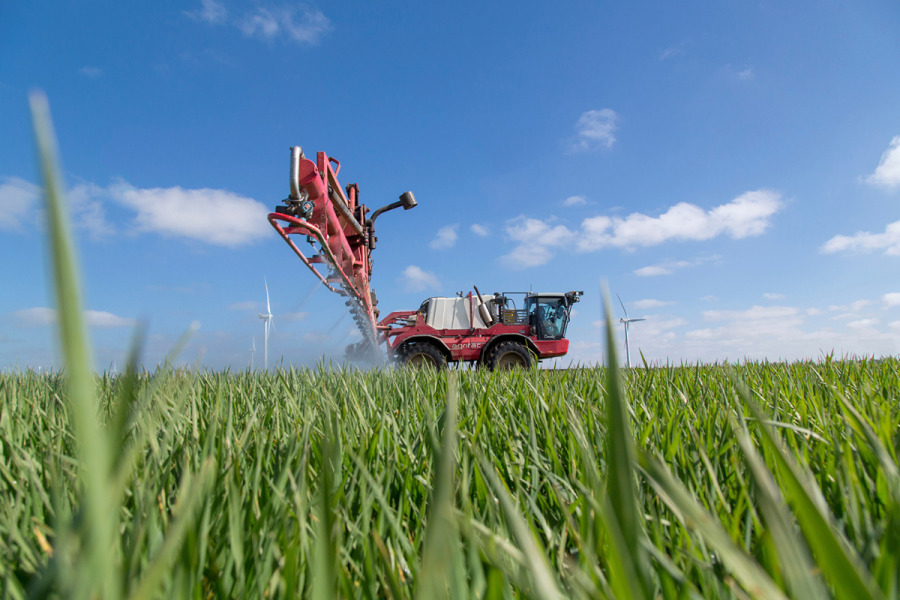A leaf sampling service is supporting Herefordshire farmer, Mark Wood, to live by his mantra of only treating a crop with what it needs. CPM unpicks the challenges this is helping to tackle.
“No matter how much you plan, you always need to adapt and be open to improvements.”
By Janine Adamson
Sitting in the farm office on a rather bleak spring day with further snow forecast, you wouldn’t blame Mark Wood if he felt a little blue about the season ahead. Yet as he proudly shares home-reared bacon sandwiches, it’s his pragmatism that shines through.
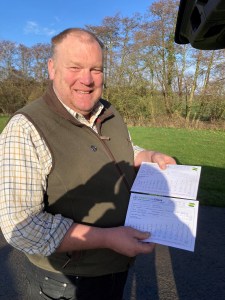
Herefordshire farmer Mark Wood’s mantra is to only do what a field needs, be it cultivation, disease management or nutrition.
“We don’t have a perfect scenario here so it’s important to be realistic,” he explains. “We farm by making the most of the soils and land that we have to try and overcome the weather extremes we experience. It’s highly variable at times and a sandy loam is quite unforgiving of that. Being efficient is essential.”
Thanks to Mark’s considered approach, Peter Clay Farms is evolving. Centred around 1400ha of combinable crops, grassland and contract potatoes, a new farm shop and café is on the horizon. “We’ve had to diversify to add value following the conclusion of our contract with a retailer. I don’t like putting a label on things, but it’s farming smarter. We run our pigs in woodland and graze the sheep in awkward areas of the farm. We were already going to farmers’ markets and selling direct to restaurants, it felt a natural next step,” he explains.
It’s clear that farm manager Mark isn’t afraid to try something new to achieve the best out of a situation. He’s even included triticale in this year’s rotation on lighter land, for inclusion in wild bird seed mixes.
However, being located in south-east Herefordshire within the catchment of the phosphate-polluted River Wye means effective soil management is a priority. Early drilling dates are a must due to the Environment Agency’s concerns about run-off, but thankfully his mantra is to only do what a field requires, be it cultivation, disease management or nutrition.
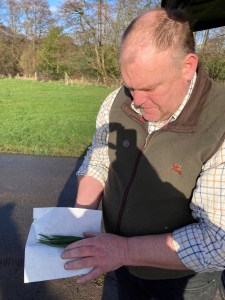
For Mark Wood, decision making means pulling everything together to come to the most appropriate response.
This makes Mark the ideal candidate for Bayer’s CropCheck – a qPCR leaf sampling service. Septoria is the only disease that grabs my attention, laughs Mark. “Although we don’t have a blackgrass problem, pitfalls remain. For us, that’s overcoming septoria,” says Mark.
“Control starts at variety selection. We drill varieties with high septoria ratings, so KWS Extase, Graham and Costello. We tried RGT Wolverine following the loss of Redigo Deter (prothioconazole+ clothianidin), hoping it would allow us to drill early to help manage BYDV. Unfortunately, it didn’t really work and led to very high disease, meaning higher fungicide spend. It also yielded poorly so returns were disappointing.”
Through experience, Mark has found that drilling early knocks back the potential disease ratings of the varieties. The reassurance that CropCheck gives enables him to tailor his approach based on the challenges of that season. “I prefer to use all cultural control methods available, with the insurance that fungicides are available if needed,” he adds.
“CropCheck is an additional tool in the armoury that adds confidence. I want to know is there latent disease and if so, how bad is it? February 2022 was a complete washout for us whereas this year it’s been dry. I’m intrigued to compare the results year-on-year.”
CropCheck is a partnership between Bayer and NIAB, providing complimentary leaf testing for latent septoria and yellow rust in winter wheat. Growers and agronomists work alongside Bayer’s commercial technical managers to identify objectives and then order test packs. Once received at the lab, results are returned within 48 hours, giving vital in-season insight, explains Bayer’s Gareth Bubb.
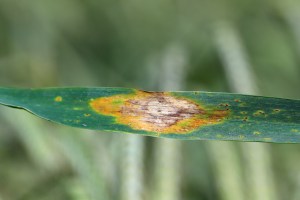
CropCheck leaf sampling service is helping to overcome septoria, the main disease experienced by Peter Clay Farms.
“It’s widely known that identifying and quantifying disease before symptoms are visible is critical in effective decision making,” he says.
“CropCheck provides validation and aids prioritisation, especially useful around T1 and T2 timings. For someone like Mark, whose average field is 5ha, it’s even more important to manage time and workload across multiple drilling dates and scenarios.
“However, it’s most effective when used alongside wider intelligence such as variety traits, weather and drilling dates. This is particularly the case in a preventative situation,” stresses Gareth.
For Mark, decision making means pulling everything together to come to the most appropriate response. To him, CropCheck is just another layer of information.
Gareth explains the importance of not making assumptions. “CropCheck actually provides data to make decisions, rather than applying fungicides based on what we think might be there,” he adds.
Mark is part of Bayer’s national snapshot initiative – one of 15 farmers partnering with the company to track disease progression across two varieties with differing septoria ratings. Part of this includes weekly testing through the spring and early summer.
Beyond this, anyone can request a CropCheck test. Although there’s no specified growth stage timing for when testing should take place, T1 and T2 are the logical targets, states Gareth. “The lab turns the results around quickly, so decisions can be made right up to the wire. We recommend testing five working days ahead of planned application, making testing on a Monday ideal for receiving results back in the same week.”
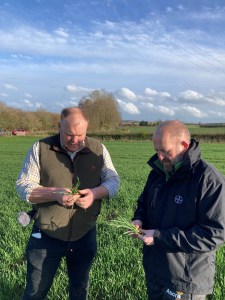
Building strong relationships has proven key in supporting Mark Wood to overcome the challenges that come his way.
As well as a pragmatist, Mark is an evident team player and collaborator. Building strong relationships with both Gareth and his agronomist has facilitated enviable agility. “You don’t have the same ‘get out of jail free card’ that we used to have with eradicant fungicides. Coupled with the highs and lows of the weather we experience, there’s no choice but to constantly fine-tune,” says Mark.
“A good relationship with your agronomist is vital. No matter how much you plan, you always need to adapt and be open to improvements. CropCheck is great because it’s a conversation starter between myself, as the farmer, and my agronomist. It facilitates important discussions.”
Although taking a preventative stance on disease control, Mark stands firm on only treating a crop with what’s necessary. No doubt this approach helped him to win the ADAS fungicide margin challenge not once, but twice.
He explains that because the farm’s yet to experience yellow rust to his knowledge, he sees no necessity to spray at T0, unless a problem arises. “I prefer to save folpet for T1, but if disease levels were especially high, I’d have to revaluate that decision. I also don’t treat specifically for eyespot, I’d rather concentrate on selecting an active to control that and septoria in one, usually based on prothioconazole (eg Aviator (bixafen+ prothioconzole) or Ascra (bixafen+ fluopyram+ prothioconazole).”
This smart, considered approach is reflected across the board. For the farm’s oilseed rape, Mark restricts his choice to Clearfield varieties only, to prioritise control of broadleaf weeds and enable use of Kerb (propyzamide). He’s also taken the decision to ease off on fungicides, due to the continued uncertainty of the crop. “I see little benefit in autumn fungicides given where we are,” he reflects honestly.
However, this year’s OSR crop looks positive and Mark intends to use risk assessment tools coupled with seasonal information to ensure he can apply a single sclerotinia spray. He’s aiming to get the timing ‘spot on’, to reduce the chance of having to return a second time.
As with most things, there are unexpected bumps in the road, or in this case, farm track. For Peter Clay Farms, this was an unintended result of prioritising soil health and minimising disturbance. “Yes, we’ve reduced our cultivations but we’ve spread resistant ryegrass by mistake. That’s our new problem,” says Mark.
Perhaps a perfect opportunity to test his willingness? Indeed, in this case Bayer suggested Mark had weed samples screened for resistant genes, to truly understand what he was up against. As feared, they tested positive for RRR resistance to a range of herbicide actives.
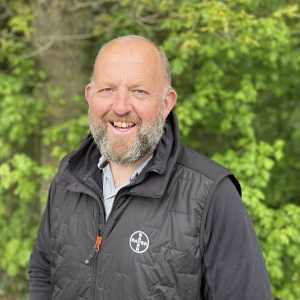
CropCheck provides data to help make decisions, rather than applying fungicides based on what is thought might be there, says Bayer’s Gareth Bubb.
Gareth stresses that it’s simply part of the service and relationship that he’s built with farmers such as Mark. “We provide the screening as we believe this additional insight is useful to both Bayer and the farmer. Site specific resistance information is important because there’s huge variability out there. If you can understand the gravity of the problem, you’re better informed to use all available cultural control methods, topped up with herbicides as necessary. Again, it’s fine-tuning the programme.”
Evidently, being adequately informed is paying off. As a former AHDB Monitor Farm, Mark isn’t afraid to share his experiences and acknowledges the importance of benchmarking. He admits that transparency isn’t for everyone, but continues to be honest and collaborative, including renting out one of the farm’s drills to neighbours.
“This won’t work for all scenarios, but we own a Mzuri drill and rent it out to trusted neighbours. It wouldn’t have made financial sense otherwise because we still need our original drill,” says Mark. “But it’s been key in us focusing on soil structure and only reacting to what an individual field requires. This way we maintain flexibility and avoid becoming blinkered by a strict whole-farm system.”
Now Mark hopes to measure the results of his experimentation by using data more effectively. He recently signed up for Bayer’s FieldView. “Let’s face it, data management has to be easy and for years it hasn’t been,” he says. “But suddenly, things are improving and it’s possible to collate data and overlay it to make improved decisions. This is definitely the next step for me.”
FieldView is Bayer’s digital farming platform that aims to translate and collate complex data into simple insights. Machine-generated data is combined with satellite field health imagery in one account. As a cloud-based system, data can then be accessed by anyone given authorisation via phone, iPad or farm computer.
“The drive plugs into the combine or tractor diagnostic port and captures a wealth of crop and operational data. This includes fundamentals such as yield, moisture, variety and application rates, but also equipment location and speed,” explains Gareth.
“Ease of data access is an obvious advantage, but perhaps the greater benefit is the ability to turn that data into practice on farm. FieldView will offer Mark the ability to dissect any field area for in-depth evaluation and build a library of field performance. This will highlight under-performing areas and offer some insight as to why.
“I’m really looking forward to seeing what Mark does with this additional intelligence, no doubt it’ll help to support his approach in getting the very most from what he has available to him.”
Beyond introducing tools such as CropCheck and FieldView, Mark’s overall aim is to ensure the business is fit for the next generation. He remains proactive in the local community through involvement with the Green Man Group – individuals dedicated to combatting the River Wye pollution. He’s also a member of national training body, TIAH (The Institute for Agriculture and Horticulture), and hosts ADAS trials.
He lists the improvements made during recent years, “From improving land drainage to planting hedgerows, we’re farming long-term here,” he smiles. “Yes, we need to make money and be profitable, but I hope this is something our grandchildren can eventually take pride in,” he concludes.
Forward-thinking farmers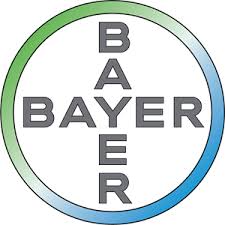
With robotics, gene mapping and molecular markers, digital technology and bio-chemistry, it is a dynamic time for anyone involved in agriculture.
Challenges lie ahead for UK agriculture, such as improving productivity while minimising its environmental footprint. But farmers have always had to deal with change and adopt new ideas and technology.
Bayer is at the core of these agricultural advances, working with farmers throughout the UK and further afield to trial and develop new diagnostic tools and evaluate different farming strategies, coupled with exciting plant breeding and product development programmes. It will help us develop innovative solutions and services to assist farmers achieve profitable and sustainable agronomic practices.
Despite the challenges facing UK agriculture there is much to look forward to. This series of articles focuses on how innovation and partnership between farmer and industry will help us face the future together.
This article was taken from the latest issue of CPM. For more articles like this, subscribe here.
Sign up for Crop Production Magazine’s FREE e-newsletter here.

